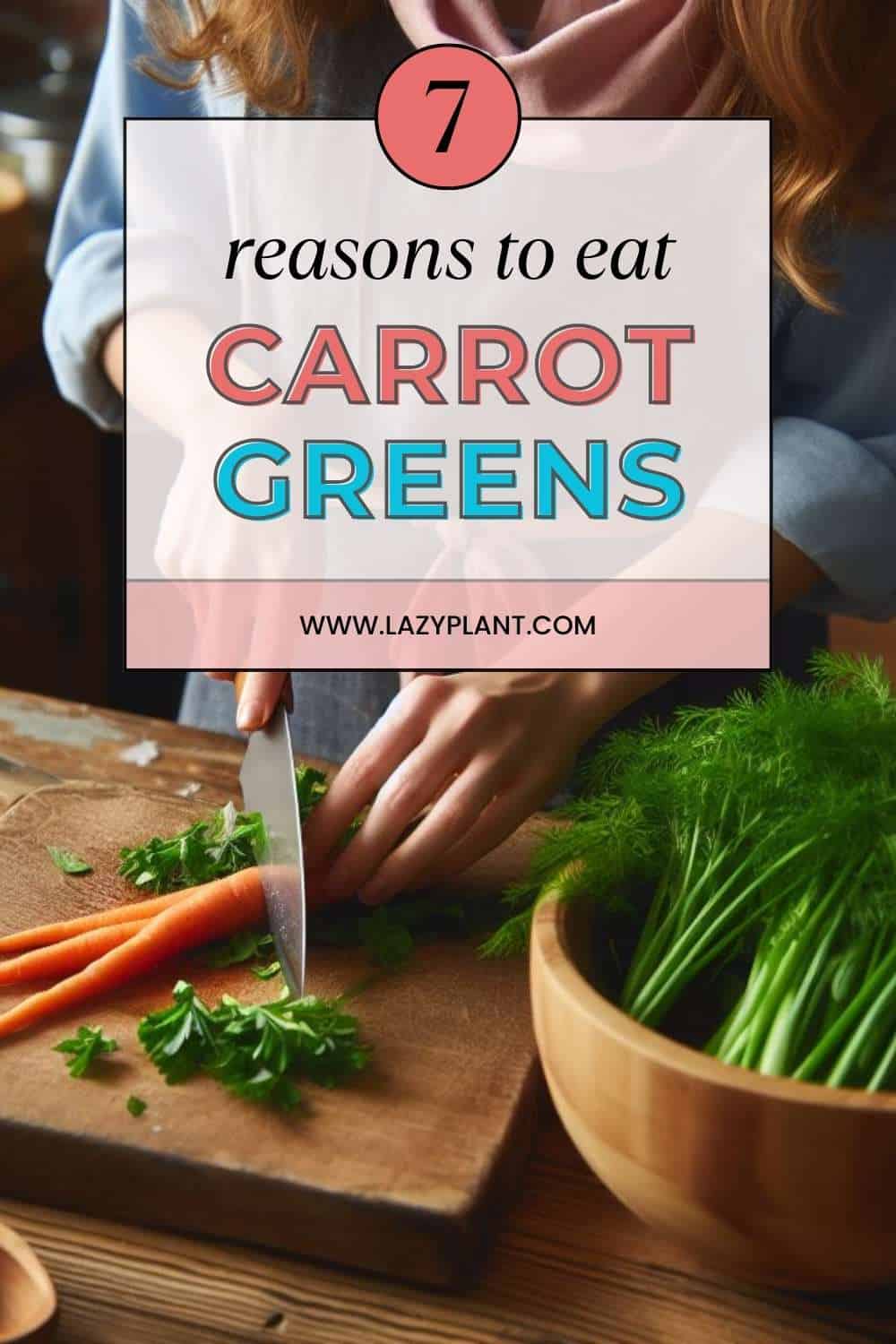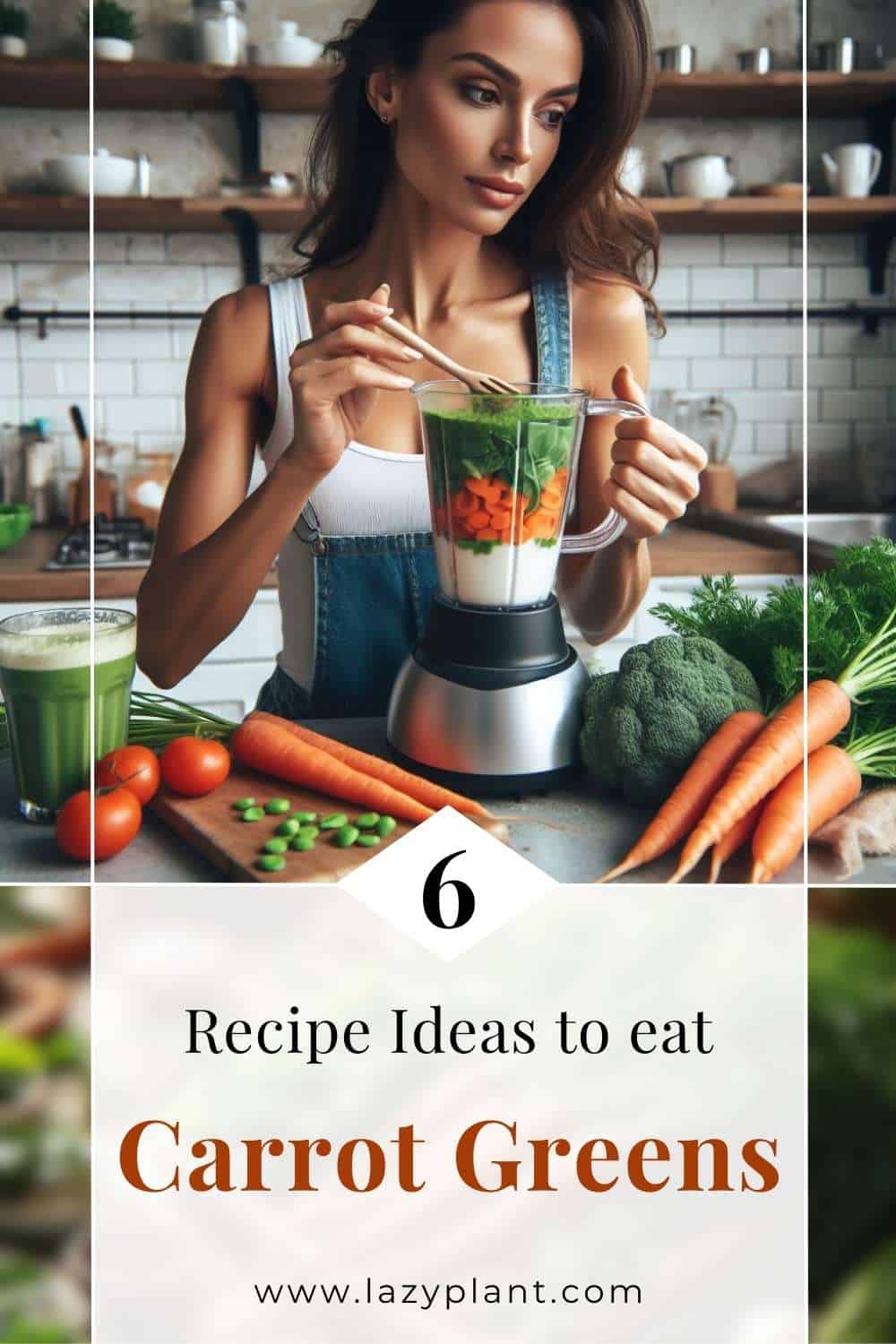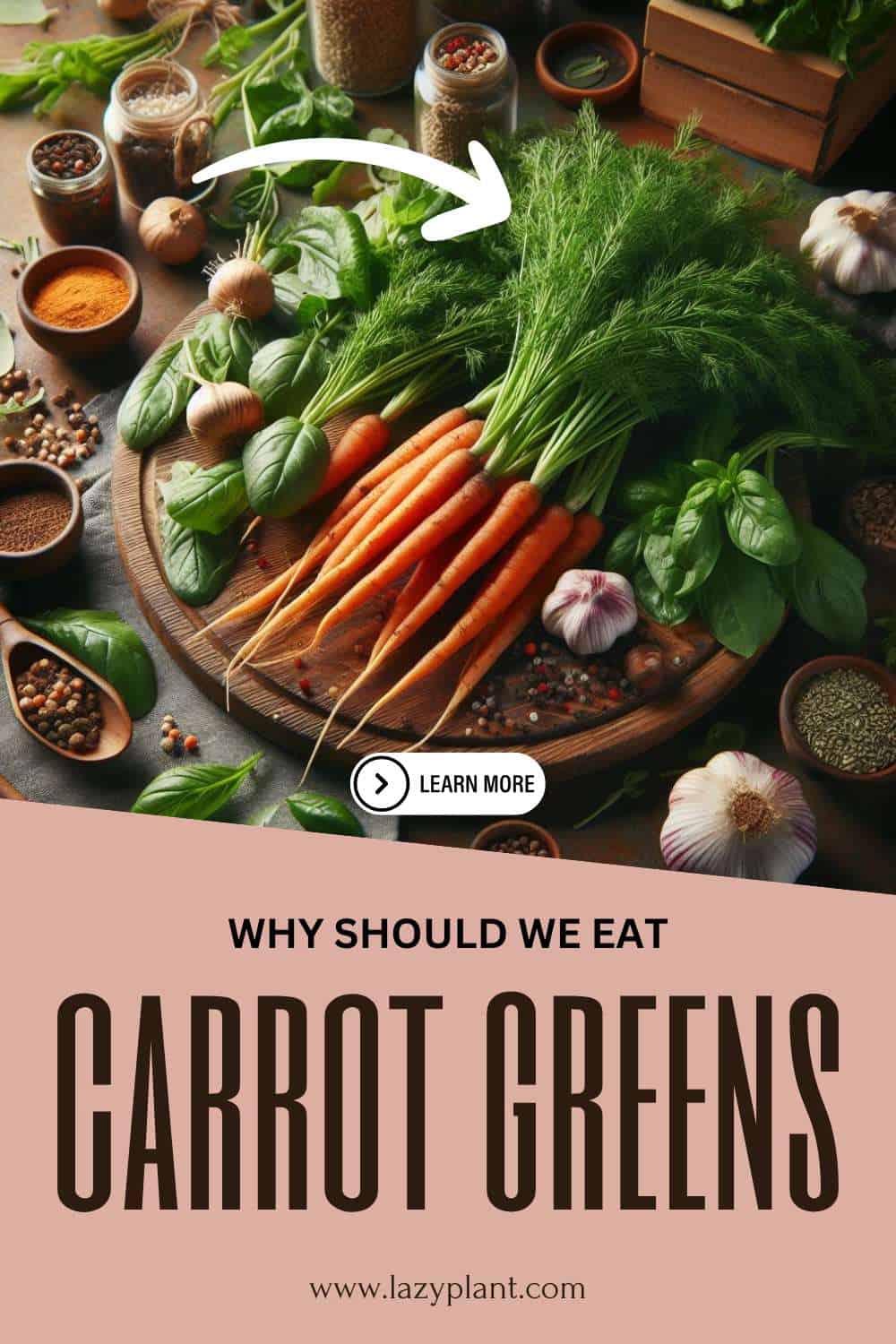Are carrot tops edible?
Not only are carrot leaves edible but they also have a superior nutritional value. You can eat them raw or cooked in many healthy recipes.
However, you should avoid eating carrot greens if you have a carrot allergy or intolerance or a hard time finding organic carrot greens.
Is carrot allergy common?
No, actually. However, if you have a food allergy, better to consult a registered nutritionist before start to consume carrot tops or make any major change to your eating habits.
In fact, allergic reactions to carrots affect up to 25% of food-allergic subjects.[1]
Eat only organic carrot greens
Conventionally grown carrots may be treated with pesticides to control pests and diseases. Thus, carrot greens are most likely to have pesticide residues.
To ensure that carrots are free from pesticides, you may choose organic carrots, which are cultivated using organic farming methods that avoid the use of synthetic pesticides and fertilizers.
When purchasing carrots, you can look for labels that indicate they are certified organic.
Pesticide residues in carrot greens, like in other vegetables, can depend on several factors, including the farming practices used and whether pesticides were applied during cultivation.
While the concentration of pesticides is generally higher on the surface of the plant, the roots and greens of carrots are not immune to potential residues.

Washing carrot greens with this homemade, chemical-free solution and using a vegetable brush can help remove surface residues.
Also, you could eat the organic carrot root with the skin. Unpeeled carrots are healthier. The skin of all vegetables and fruits is the richest part in nutrients. Actually, the carrot root as well as carrot tops have compounds that promote weight loss.
Nutritional value & health benefits of carrot leaves
Carrot leaves are rich in many nutrients, such as vitamin C, beta-carotene and dietary fiber, as well as many minerals. They’re packed with phosphorus, potassium, calcium, magnesium, manganese, zinc and iron.[2]
Also, they have only a few calories. Carrot greens are an ideal ingredient for any dish that aims to weight loss. Moreover, as carrot greens contain negligible amounts of sugar, people on keto or people with diabetes can incorporate them into their diet routine.
Omega-3s
Actually, carrot leaves are among the few plant-based sources of omega-3 fatty acids! They contain about 1.16 grams of omega-3s per 100g.
Eating lots of foods high in omega-3s is vital for good health. Modern Western diets are low in omega-3s, causing inflammation and obesity.[3]
Vitamin C
Additionally, carrot greens have decent amounts of vitamin C. They contain about 34 mg of vitamin C per 100g of dry weight.[4]
Eating carrot leaves is good for your eyesight
Carrots are known for protecting eyesight, mainly due to their high content of vitamin A and carotenoids. Carrot leaves contain moderate amounts of carotenoids as well. They contain about 8.7 mg of beta-carotene per 100g (dry weight). In fact, only a few foods are richer in beta-carotene than carrots.
Protein in carrot tops
Moreover, carrot leaves are great plant-based sources of protein. Actually, they’re 15% protein.
Therefore, carrot tops are ideal ingredients for a post-workout smoothie. Moreover, carrot leaves are high in antioxidants. They’ll help neutralize exercise-induced free radicals, promoting muscle recovery!

Fiber
Additionally, carrot leaves are high in dietary fiber. They’re about 12% fiber (dry weight). A fiber-rich diet has been linked to a decreased risk of obesity and better health.
Eat carrot tops to get chlorophyll
Moreover, carrot greens contain high amounts of chlorophyll. Eating foods high in chlorophyll is beneficial for the body. Chlorophyll boosts the immune system, helps the body to detox, and has anti-aging properties.
Eat carrot leaves for calcium
In addition, carrot greens are particularly high in calcium. They contain about 1,970 mg of calcium per 100g (dry weight). Actually, carrot tops are among the richest plant-based foods in calcium!
Why don’t we eat carrot leaves?
Carrot greens aren’t commonly consumed, as they can have a slightly bitter taste, which may not be as palatable to some people compared to the sweetness of the carrot root.
The leaves can have a tougher texture compared to the tender root. Cooking or chopping them finely can help make them more enjoyable, though.
If you grow your own carrots, you could trim young leaves. They’re more tender than the leaves of a grown plant.
If carrot leaves are edible, why can’t I find them in stores?
Although you can eat carrot greens, it’s really difficult to find them in supermarkets. Most people don’t consume carrot tops because they don’t know their nutritional value.
Furthermore, carrot leaves draw moisture from the carrot root. Therefore, growers remove them. Cutting carrot tops increases the shelf life of the carrot root.
Keep in mind that in many Western cuisines, there isn’t a strong culinary tradition of using carrot greens in everyday dishes. As a result, people may not be familiar with how to prepare or incorporate them into meals. If there isn’t demand for a product, stores won’t sell it.
How to eat carrot leaves?
You can use carrot leaves in many recipes. You can eat them raw or cooked in smoothies, salads, soups, sauces, pies, and sandwiches.
How do carrot greens taste?
Carrot greens have a flavor that is often described as earthy, bitter, and herbaceous. The taste is somewhat similar to other leafy greens but can have a slightly more intense and distinctive flavor.
The bitterness in carrot greens is a characteristic that some people may find appealing.
The flavor profile of carrot greens can vary based on factors such as the freshness of the greens and the specific variety of carrots. The younger, tender leaves are generally milder in flavor compared to older, more mature leaves.
If you’re unsure about the taste, you might start by incorporating small amounts into dishes to see how you like the flavor.
Carrot recipe Ideas
- In salads: Chop the young and tender carrot leaves and add them to your salads for a fresh and nutritious boost.
- Pesto: Create a pesto by blending carrot leaves with ingredients like garlic, nuts (such as pine nuts or almonds), Parmesan cheese, olive oil, and salt. Use the pesto as a sauce for pasta or a spread for bread.
- Smoothies: Add a handful of carrot leaves to your smoothies along with other greens and fruits for added nutrients.

- Soups and stews: Chop carrot leaves and add them to soups, stews, or broths during the cooking process for extra flavor and nutrition.
- Sautéed or stir-fried: Sauté or stir-fry chopped carrot leaves with other vegetables as a side dish. Consider adding garlic, onions, or your favorite herbs and spices for added flavor.
- Herb garnish: Finely chop carrot leaves and use them as a garnish for various dishes, providing a hint of freshness.
When using carrot leaves, keep in mind that younger leaves are often more tender and milder in flavor.
Ensure that the leaves are thoroughly washed, especially if they are not from organic sources, to remove any potential pesticide residues.
Experiment with different preparations to find a method that suits your taste preferences.
How to cook carrot greens if I have a sensitive stomach?
If you have a sensitive stomach, it’s important to prepare carrot greens in a way that is gentle on your digestive system. For instance, you could sauté carrot greens. Avoid consuming them raw.
Sauté the carrot greens for a short time, though, just until they wilt and become tender. Avoid overcooking to retain their nutritional value.
How much can I eat?
The appropriate amount of carrot greens or any other food depends on various factors.
As a side dish or part of a balanced meal, a serving size of carrot greens could be around 1 to 2 cups. However, this can vary based on personal preferences and the context of your overall diet.
If you have a sensitive stomach or specific dietary concerns, start with smaller portions and gradually increase as tolerated.
There’s no specific daily recommendation for carrot greens, but they can be included in your diet a few times a week. Variety is key, so include a range of vegetables in your meals.
Boost your antioxidant intake with herbs
Herbs and vegetables are among the richest foods in antioxidants. These compounds improve immunity and enhance weight loss.
You could eat carrot tops with other herbs and vegetables for good health. Many greens have been consumed for centuries in the Mediterranean Diet. There are some many recipes that incorporate carrot greens for added flavor and nutrition:
Herb-infused carrot greens pesto: Blend all ingredients in a food processor until smooth. Serve over pasta or as a dip. Ingredients: Carrot greens, basil, garlic, pine nuts, Parmesan cheese, olive oil, salt, and pepper.
Carrot greens and cilantro hummus: Blend all ingredients in a food processor until creamy. Enjoy with pita or veggies. Ingredients: Chickpeas, tahini, carrot greens, cilantro, garlic, lemon juice, olive oil, cumin, salt, and pepper.
Carrot greens and mint smoothie: Blend all ingredients for a refreshing and nutrient-packed green smoothie. Ingredients: Carrot greens, mint leaves, spinach, banana, yogurt, and honey.
Herbed carrot greens quinoa salad: Toss all ingredients together for a hearty and flavorful quinoa salad. Ingredients: Cooked quinoa, carrot greens, parsley, cherry tomatoes, cucumber, feta cheese, olive oil, lemon juice, salt, and pepper.
Carrot greens and basil bruschetta: Mix diced tomatoes, chopped carrot greens, and basil. Spoon onto toasted baguette slices.
Herb-infused carrot greens rice: Mix the herbs and cooked rice for a fragrant and flavorful side dish. Ingredients: Cooked rice, carrot greens, dill, chives, lemon zest, butter, salt, and pepper.
Adapt these recipes based on your preferences and the herbs you have available. Enjoy exploring the diverse flavors of carrot greens paired with different herbs!
Do carrot greens support Weight Loss?
Carrot greens may contribute to a weight loss-friendly diet. Above all, they promote satiety with only a few calories. Foods high in fiber, such as carrot greens, are often recommended for weight management.
In addition, incorporating carrot greens into salads, smoothies, or other dishes can add variety to your meals, making it easier to stick to a balanced and enjoyable diet.
vitamins A and C, calcium, and potassium in carrot tops also play a beneficial role in weight management, as well as overall health and well-being.
Can carrot tops make me fat?
However, there are certain circumstances or choices that might contribute to weight gain.
For instance, if you prepare carrot tops with high-calorie additions such as dressings, vegetable oils, or other calorie-dense ingredients, it can contribute to increased calorie intake.
If carrot tops are prepared using unhealthy cooking methods, such as frying or excessive use of fats, it can increase the calorie content of the dish.
Avoid cooking healthy, nutrient-dense foods, like carrot leaves with fattening foods, including oil or butter. Just a tablespoon of any vegetable oil has about 125 calories! Way more calories than a serving of carrot greens.
In fact, raw carrot grrens have only 22 calories per 100g!
Adverse effects of eating carrot tops
While carrot tops are generally safe to eat, it’s essential to be aware of potential adverse effects for certain individuals or in specific circumstances.
Carrot greens contain certain compounds called alkaloids and nitrates. While these are present in small amounts and generally considered safe, consuming extremely large quantities might lead to mild toxicity symptoms. Small portion sizes of 1–2 cups a couple of times per week won’t cause any side effects, though.

Moreover, carrot tops, like many leafy greens, contain oxalates. High levels of oxalates can contribute to the formation of kidney stones in susceptible individuals. If you have a history of kidney stones, it’s advisable to moderate your intake.
Carrot greens contain goitrogens, which can interfere with thyroid function. While the levels are not high enough to cause significant issues in most people, individuals with thyroid conditions may want to limit their intake.
Some individuals may be allergic to certain components of carrot greens. If you have known allergies to related plants like parsley, cilantro, or celery, exercise caution and monitor for any adverse reactions.
If you have specific concerns or conditions, it’s advisable to consult with a healthcare professional or a registered dietitian before incorporating carrot greens into your diet.
But as most people use small amounts to add flavor and aromas in salads and side dishes, carrot greens are rather unlikely to cause any adverse effects.